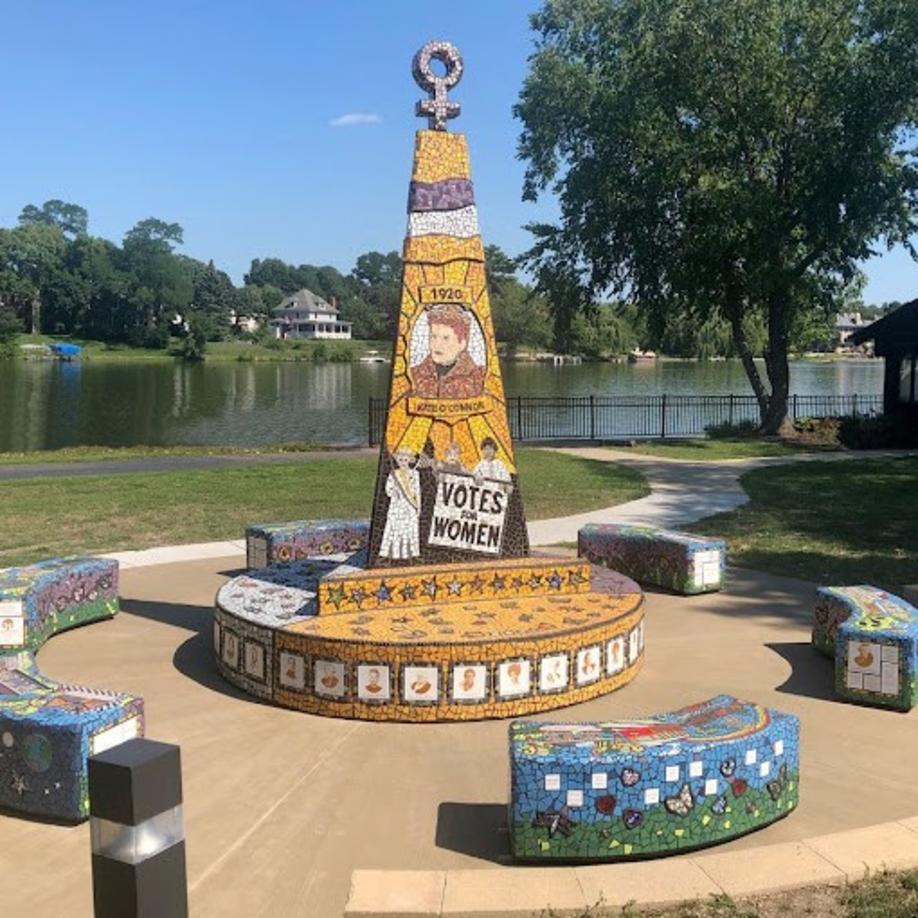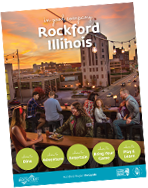Rockford Women’s Suffrage Plaza
Author: Mary McNamara Bernsten, Executive Director of the Rockford Area Arts Council
Nothing says Women’s History Month like the Rockford Women’s Suffrage Plaza!
The Rockford Women’s Suffrage Plaza (RWSP) is Rockford’s first public art installation honoring women’s leadership and activism. It was created to commemorate the 100th Anniversary of women’s right to vote. With the help of over 200 community volunteers, it was dedicated on October 31, 2020, and is located at 200 Y Boulevard, next to the YMCA’s Log Lodge building. After nearly three years of fundraising efforts, the sculpture is paid for, and its indefinite custodianship is secured with the Rockford Area Arts Council.
The three-sided composition tells an inclusive, fact-based history, featuring Rockford suffragist Kate F. O’Connor, Rockford voting rights activist Dr. Constance Goode, and Future Voters. The ratification of the 19th Amendment, on August 18, 1920, prohibited the states and the federal government from denying the right to vote to citizens of the United States on the basis of gender. White women were the first women able to vote without legal barriers and extreme discrimination (O’Connor). Only when the Voting Rights Act of 1965 was passed — a landmark piece of federal legislation that prohibited racial discrimination in voting — could women of color exercise their right to vote (Goode). The group of diverse girls represents our future women voters and activists.
The RWSP is the first public art owned and maintained by the Rockford Area Arts Council. When considering its custodianship of the Plaza, the Arts Council examined the fine craft-womanship and significant community impact of the sculpture. RWSP artist, Susan Burton, has work installed all over Illinois and is known, nationally, for her significant contribution to the type of mosaic work represented by the Plaza, and her commitment to community-build projects.
Additionally, the Plaza represents several significant components of the importance of public art:
- Public art is uniquely accessible—people can experience public art in the course of their daily lives
- Public art is also a distinguishing part of our public history—art is a reflection of our rich and diverse cultures; art reflects and reveals those who live in our community; and public art demonstrates to visitors the values of our community’s residents and leaders.
- Public art provides an opportunity for self-reflection and awareness—it is a unique vehicle for empathy and compassion.
- Public Art adds real value to our community—in terms of economic development and the recruitment/retainment of our workforce, culture, education, civic engagement, and mental and physical health. Art adds real value, both in terms of dollars and sense—the sense of instilling pride, a sense of place, and strong community identity.
During Women’s History Month, it is critical for all US citizens to reflect on the ways in which women shaped our country. Historically, and today, women have faced greater barriers than men when it comes to attaining leadership roles, and equity in general. The journey continues and the Rockford Women’s Suffrage Plaza is a visual reminder of our past, present, and future; the Plaza is a reminder, especially to women, that we have important skills, valuable perspectives, and the empathy needed to improve our lives and the lives of our fellow Americans. The Arts Council, and other women’s advocacy groups, stand in solidarity with women in leadership positions in Rockford. Although our equity work continues, at work and at home, women’s place in our society is more elevated and respected today, than ever before. And the work of the women highlighted in Burton’s sculpture—past, present, and future—will determine our path hereafter.
If you have not had the opportunity to visit the Rockford Women’s Suffrage Plaza, at 200 Y Blvd, I encourage you to do so! Visit the monument with a friend, your book club or church friends, your daughters, and sons. It is an experience of empowerment to sit and reflect on the leadership of others, and how significantly their actions impact our daily lives.














